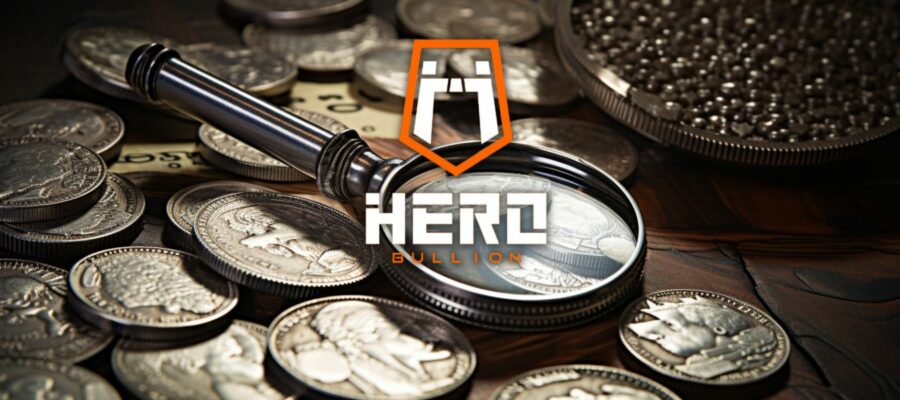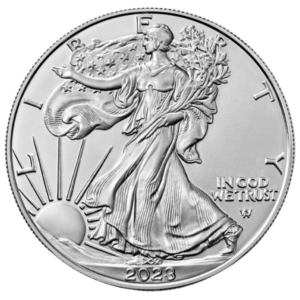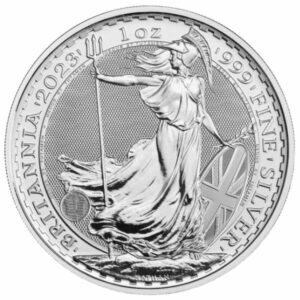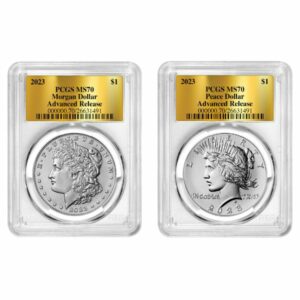How to Tell if a Coin is Real Silver

Investing in silver is a time-honored method of expanding and diversifying a portfolio. Silver coins allow collectors to stack high quality, beautiful pieces made with an exceptional level of precious metal fineness. But as the global counterfeiting industry becomes more efficient, new technologies have allowed malicious actors to double-down on their efforts to scam inexperienced buyers into buying fake silver bullion.
The last thing any investor wants is to find out that their hard-won silver collection contains counterfeit coins. It isn’t just counterfeiting that investors need to worry about, either. Some coins may be marketed as .9999 pure but actually contain very little actual silver bullion. We’re here to help you stay protected against counterfeits, silver-clad coins, and all sorts of scam products on the precious metals market.
Today, we’re going to explain how to tell if a coin is real silver. We’ll show readers how to evaluate coins for silver content at home, consult experts, and more. Keep reading for a detailed guide on evaluating silver coins for actual silver content.
Physical Characteristics
The physical characteristics of a coin can actually help you as you figure out how to tell if a coin is real silver. Silver coins often have specific weights and sizes, and irregularities in the total weight of a coin can be a dead giveaway that you have an illegitimate coin on your hands. Below, we’ll explain how you can use the physical characteristics of a coin to determine whether or not it contains actual silver.
Weight and Size
Your first step in how to tell if a coin is real silver is to figure out how much the silver in your coin should weigh. Coins with a total weight of less than their silver content are almost certainly fake. But you can also determine if a coin is counterfeit using this method. Popular distributors like the U.S. Mint and the British Royal Mint list the total weight of their silver coins. If you purchase a silver coin from a major mint and it weighs less – or more – than they list on their website, chances are high that you’re dealing with a fake.
Carefully evaluate the weight and size of your coins. When researching how to tell if a coin is real silver, it’s necessary that you put some research in to see how actual silver coins are supposed to look and feel.
Sound Test: Ringing Vs. Thud
Do you know how to tell if a coin is real silver using the sound test? That’s right. You can actually figure out if a coin is real silver just by hitting it against another metal or a table. Coins that are real silver should make a high-pitched ring when struck against other metals, while silver-clad or fake silver coins are more likely to make a low, dull thud when dropped onto a table. If you want to know how to tell if a coin is real silver, try the sound test.

This isn’t definitive. We recommend trying several different inspection methods if you really want to know how to tell if a coin is real silver. Some coins may make a duller sound, and it’s unwise to trust your hearing along with what could be hundreds of dollars in investment-grade silver.
We also don’t recommend dropping silver coins frequently – or at all. This test is best performed on junk coins containing 90% silver. In other words, don’t drop your expensive American Silver Eagles onto the countertop just to tell if they’re made of real silver bullion.
Visual Inspection: Details and Mint Marks
If you’re still wondering how to tell if a coin is real silver after the sound test, taking a closer look at the coin’s details and mint marks can help. Just like the weight and technical specifications of a coin, mints often list coins’ details and mint marks on their websites. The important details of a coin’s designs, mint mark, and security features should match the details on your own coin. If these details are irregular, you might have a fake coin.
Like we mentioned with the sound test, visual inspection is not completely foolproof. It can be easy to miss key details when evaluating a coin at home. Later in this guide, we’ll discuss how to tell if a coin is real silver using professional inspection and consultation. For now, we recommend taking a close look at your coins – preferably using a tool, such as a magnifying glass, to examine the details of the silver pieces.
Basic Testing Techniques
There are also basic coin testing techniques that explain how to tell if a coin is real silver. There are a number of techniques you can employ, but we’ll cover two of the main ones: the magnet test and conductivity test.
Magnet Test: Reactivity
Magnet reactivity is one of the easiest answers for how to tell if a coin is real silver. Silver isn’t magnetic, so it won’t react when a magnet is pressed against it. Fake silver coins will be pulled closer to the magnet. The same is true with gold. If you’re wondering how to tell if a coin is fake gold, the magnetism test can help you. Silver and gold should never actually react to the pull of a magnet.
Conductivity Test: Ice Cube
Products made of real silver are highly conductive. The ice cube test is popular with silver collectors for a couple or reasons. First, it’s effective. The conductivity of silver bullion is a scientific fact, and it’s hard to replicate the conductive nature of the precious metal with other materials. Additionally, the ice cube test is simple to do and is unlikely to seriously damage your silver coins.
To do the ice cube test, just set an ice cube on top of a product that is supposed to be silver. We recommend implementing a control in this experiment as well. Put another ice cube on a non-silver metal and watch how quickly the cubes melt. Because of the high conductivity of silver, the ice cube on your coin should melt far quicker than the ice cube on the non-silver item – as long as your product is actually silver. If you want to figure out how to tell if a coin is real silver, the ice cube test is a safe and reliable option.
Advanced Testing Options
If you’re dealing with extremely expensive items and want to know how to tell if a coin is real silver, you might need to try some of our more advanced testing options.
Acid Testing
Acid testing is an advanced method of how to tell if a coin is real silver, but many collectors enjoy this test. It’s pretty simple, too. Just take a drop of nitric acid on your silver product. If the coin is between 90 and 100% pure silver bullion, the acid should turn to a creamy color. If it’s 65 to 75% silver, it’ll be light green. And if the color of the nitric acid doesn’t change, then you might have fake silver on your hands.
X-Ray Fluorescence (XRF) Testing
This is one of the more advanced – and potentially expensive – methods of how to tell if a coin is real silver on our list. Still, X-ray fluorescence testing is non-destructive and can help you determine the silver content of your coin without risking damage.

Most professional coin dealers use hand-held XRF guns, which help them determine the purity of a silver coin. Using XRF provides almost immediate results, and they’re very difficult to disprove. Efficient XRF guns will actually provide results in under fifteen seconds and can list the silver purity of a piece in percentages.
Spotting Counterfeit Coins
Spotting counterfeit coins can be tough, especially if you’re inexperienced at buying, testing, and selling silver bullion. Below, we’ll discuss how to tell if a coin is real silver or a counterfeit using two methods: spotting the signs and looking for minting errors and inconsistencies.
Signs of Counterfeit Silver Coins
Color, brightness, and smoothness are all features that characterize a legitimate coin. In addition, some coins include micro text, small engravings that help to prove their authenticity and deter counterfeiting. Unnecessary wear and tear on the coin might also be able to tip you off, although some genuine coins come in less-than-perfect condition. Counterfeits will not include the micro engraving included on genuine silver coins. If you want to know how to tell if a coin is real silver, looking the coin over yourself is the perfect place to start.
Minting Errors and Inconsistencies
Minting errors on bullion coins are relatively rare, but they do happen. Generally, any mint errors found on authentic silver bullion coins are likely to be cataloged on popular coin lists and guides. If your silver coin includes an error that nobody in the industry has ever heard of, there are only two possibilities: it’s either a coin of unprecedented rarity or you’re dealing with a fake coin.
Any divergence from the details that the coin is supposed to have should be an indicator that your piece might not be pure silver. Counterfeiting technology is always becoming more sophisticated, so smart investors are careful about checking their coins for mint errors, inconsistencies, or irregularities.
Research and Expert Consultation
If you can’t figure out whether or not your coin is legitimate, it might be time to reach out for some professional advice. Below, we’ll outline how to tell if a coin is real silver using historical documentation, online resources, and expert opinions.
Historical Documentation
Historical documentation should just be part of the deal when you buy a high quality silver coin. Certificates of authenticity are the basic tool we use to certify a coin, but you might also consider looking into the history of your own coin. This is especially important when you’re trading expensive, rare silver coins. If your coin is worth hundreds of thousands of dollars, you should be able to track its auction history to make sure that everything adds up.
Online Resources
Online resources are an essential part of how to tell if a coin is real silver. Pricing guides and catalogs can help you determine the details of how your genuine silver coin should look, feel, and weigh. Manufacturing mints can serve the same function; you should know exactly what details to look for before you can determine the genuineness of a silver coin.

Seeking Expert Opinions
If all else fails, reach out to an expert. Professional coin grading services can help you determine both the authenticity and the grade/condition of a silver coin. Is your coin real silver or fake? Speaking to a numismatic expert or coin dealer about your concerns can alleviate the fear that you’ve accidentally purchased a non-silver bullion coin.
Tips for Buying Silver Coins
If you want to buy pure silver coins without worrying about counterfeits or fake silver, Hero Bullion has you covered. We sell high quality silver products and personally vet our entire inventory to avoid the risk of fake coins making it into our stock. But whether you choose to buy from us or another dealer, we’ll help you stay safe with some tips for buying silver coins.
Trusted Dealers
Only do business with dealers you trust. You shouldn’t even have to worry about how to tell if a coin is fake silver when you work directly with a reputable, respected manufacturer.
Price Considerations
Always shop around for the right price before buying a silver coin. Coins minted with pure silver come with high premiums over spot, so it’s tough to find a really solid deal without overpaying. To get the best deal on real silver coins, look for dealers offering discounts – or consider buying bulk. Many sellers offer reduced premium costs when you buy large or multiples of popular silver coins.
Final Thoughts: How to Tell if a Coin is Real Silver
If you’re still wondering how to tell if a coin is real silver, we’re happy to provide you with several options to test your silver coins. Silver bullion coins can be tested using visual inspection, advanced testing methods, and a number of additional tools.
Do you still have questions about how to tell if a coin is real silver? We’re happy to help. Our goal is to make investing in silver as easy as possible, so never hesitate to reach out to Hero Bullion’s dedicated customer service line.
About The Author
Michael Roets
Michael Roets is a writer and journalist for Hero Bullion. His work explores precious metals news, guides, and commentary.
